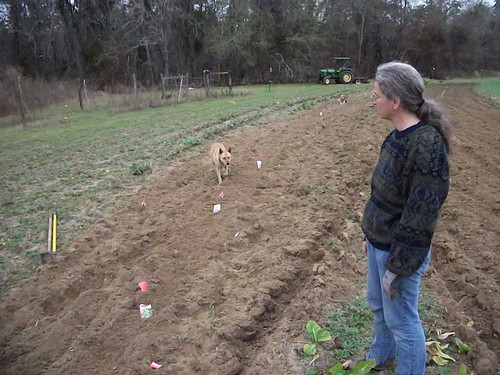
by John S. Quarterman, Lowndes County, Georgia, 6 February 2012.
Not digging, she hopes? We just planted potatoes there! Here’s a slideshow: Continue reading

by John S. Quarterman, Lowndes County, Georgia, 6 February 2012.
Not digging, she hopes? We just planted potatoes there! Here’s a slideshow: Continue reading
 Small farmers, independent farmers, competing against massive
corporate factory farms, decided to support Occupy Wall Street
with food:
Small farmers, independent farmers, competing against massive
corporate factory farms, decided to support Occupy Wall Street
with food:
This is the food Mayor Bloomberg had NYPD evict.
-jsq
Farms in Lowndes county are mostly small, averaging 145 acres, with the largest category being 10-50 acres.
Of course, that’s slightly misleading since so many small farms are rented by a few larger operators, some based in other counties. Still, small farms are the easiest to wean off the pesticide teat. Given that the average age of principal farm operator in Lowndes County is 57.9, something is likely to change soon as many of those operators retire.
We already know that local farming is linking up with local markets through Hahira’s summer farmers market, which has been going on for years, increased farmers markets, and through the new Downtown Valdosta Farm Days. That looks like a good direction.
-jsq
Christopher Wanjek wrote in LiveScience 10 February 2009, Small Farms Sprout in Economic Drought:
We know this works elsewhere:When the economy gets tough, it seems that the tough get farming. Tens of thousands of small farms were created since 2002, according to new data from the Census of Agriculture.
The farming forecast isn’t entirely sunny. But packed with a cornucopia of surprise findings — such as large increases in the number and percentage of Asian, Hispanic, Black and female farmers, and a coup staged by the frigid state of Wisconsin to become the second-leading vegetable producer, behind California — the census brings promising news to those interested in reducing obesity and improving the environment.
What’s the connection? More small farms brings greater diversity of crops, more fresh and local foods, less dependency on chemical fertilizers, less concentration of manure, and less emphasis on cheap corn to make unhealthy, industrially produced beef, pork and chicken.
In Japan, were obesity is negligible and the population lives on average about five years longer than Americans do, most cities and their surroundings are filled with small farms. Farmers south of Tokyo, which has a climate similar to Washington, work year round, planting winter crops such as broccoli and hearty greens, which are then picked and delivered to local stores within a day or two. The system is called chisan, chishou, “produce local, consume local.”Unfortunately, big farms also increased during the same period, and mid-sized farms decreased. Basically, mid-sized farms can’t compete in the pesticide game, and are being absorbed by huge corporate farms while being a grass-roots movement of small farms is coming up from the bottom.
Rather than massive Monsanto farms, I choose chisan, chishou.
-jsq
 Gretchen found this one, too (think I can get her to blog?).
Judi Gerber writes about
Why Saving Farmland Is So Important:
Gretchen found this one, too (think I can get her to blog?).
Judi Gerber writes about
Why Saving Farmland Is So Important:
…without local farms, there’s no local food, or, as the American Farmland Trust (AFT) puts it: “No Farms, No Food.”.
And it’s not even just food:
Farmland is green space, even though most people don’t think of it that way. It is a significant contributor to environmental quality. As AFT states, “Farm and ranch lands provide food and cover for wildlife, help control flooding, protect wetlands and watersheds, and maintain air quality. They can absorb and filter wastewater and provide groundwater recharge. New energy crops even have the potential to replace fossil fuels.”
And there’s more:
Farmland provides fiscal stability to local governments and boosts the economy. It does this by contributing to a community’s infrastructure and helps a local economy through sales, job creation, and support services or businesses.There are some plans afoot about agrotourism in Lowndes County.One of the most unique of these support services is tourism, or more specifically, agri-tourism. There are plenty of places that people visit to see rural scenery or to enjoy the food or drink of a specific region including the wineries in California’s Napa Valley, or popular farm stays like those found in Italy, and increasingly, here in the United States.
-jsq
 Here’s something that’s widely opposed by both
the right
and
the left: the so-called
“Food Safety Enhancement Act of 2009”.
And for many of the same reasons, including:
Here’s something that’s widely opposed by both
the right
and
the left: the so-called
“Food Safety Enhancement Act of 2009”.
And for many of the same reasons, including:
Here’s how your representatives voted when this thing passed the House. The vote didn’t break down neatly by party lines. However, if you look at the cartogram, it looks like city Representatives tended to vote for it, while rural ones tended to vote against. Maybe some rural reps realized that this bill isn’t about safety: it’s about Monsanto and big argribusiness driving small farmers out of business. There’s still time to stop it in the Senate, or when it comes back to the House after being reconciled with whatever the Senate passes.